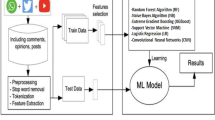Abstract
Online antisocial behaviour is a social problem and a public health threat. It is one of the ten personality disorders and entails a permeating pattern of violation of the rights of others, and disregard for safety. It prevails online in the form of aggression, irritability, lack of remorse, impulsivity, and unlawful behaviour. The paper introduces a deep learning-based approach to automatically detect and classify antisocial behaviour (ASB) from online platforms and to generate insights into its various widespread forms. Once detected, appropriate measures can be taken to eradicate such behaviour online and to encourage participation. The data for this paper was collected over a period of four months from the popular online social media platform Twitter by using pre-defined phrases linked to antisocial behaviour. Widely used machine learning classifiers: SVM, Decision tree, Random Forest, Linear regression, and deep learning architecture (CNN) were experimented with. CNN was implemented with both GloVe and Word2Vec embeddings and outperformed all the traditional machine algorithms used in the study. Standard performance metrics such as accuracy, recall, precision, and f-measures were used to evaluate classifiers and the CNN-GloVe combination (with 300 dimensions) produced the highest classification performance achieving 98.42% accuracy. Visually enhanced interpretation of the results is presented to demonstrate the inner workings of the classification process.
Access this chapter
Tax calculation will be finalised at checkout
Purchases are for personal use only
Similar content being viewed by others
References
American Psychiatric Association: Diagnostic and Statistical Manual of Mental Disorder, vol. 5. American Psychiatric Pub, Washington DC (2013)
Agrawal, S., Awekar, A.: Deep learning for detecting cyberbullying across multiple social media platforms. European Conference on Information Retrieval, pp. 141–153 (2018)
Gao, S.: Hierarchical attention networks for information extraction from cancer pathology reports. J. Am. Med. Inf. Assoc. 25(3), 321–330 (2018)
Nikfarjam, A., Sarker, A., O’Connor, K., Ginn, R., Gonzalez, G.: Pharmacovigilance from social media: mining adverse drug reaction mentions using sequence labeling with word embedding cluster features. J. Am. Med. Inf. Assoc. 22(3), 671–681 (2015). https://doi.org/10.1093/jamia/ocu041
Nguyen, D.T., Mannai, K.A., Joty, S., Sajjad, H., Imran, M., Mitra, P.: Robust classification of crisis-related data on social networks using convolutional neural networks. In; Eleventh International AAAI Conference on Web and Social Media (2017)
Majumder, N., Poria, S., Gelbukh, A., Cambria, E.: Deep learning-based document modeling for personality detection from text. IEEE Intell. Syst. 32(2), 74–79 (2017). https://doi.org/10.1109/mis.2017.23
Du, J., Michalska, S., Subramani, S., Wang, H., Zhang, Y.: Neural attention with character embeddings for hay fever detection from Twitter. Health Inf. Sci. Syst. 7(1), 1–7 (2019). https://doi.org/10.1007/s13755-019-0084-2
Singh, R., Zhang, Y., Wang, H.: Exploring human mobility patterns in melbourne using social media data. In: Wang, J., Cong, G., Chen, J., Qi, J. (eds.) ADC 2018. LNCS, vol. 10837, pp. 328–335. Springer, Cham (2018). https://doi.org/10.1007/978-3-319-92013-9_28
Poria, S., Chaturvedi, I., Cambria, E., Hussain, A.: Convolutional MKL based multimodal emotion recognition and sentiment analysis. In: IEEE 16th International Conference on Data Mining (ICDM), pp. 439–448 (2016)
Gers, F.A., Schmidhuber, J., Cummins, F.: Learning to forget: Continual prediction with LSTM (1999)
Islam, M.R., Kabir, M.A., Ahmed, A., Kamal, A.R.M., Wang, H., Ulhaq, A.: Depression detection from social network data using machine learning techniques. Health Inf. Sci. Syst. 6(1), 1–12 (2018). https://doi.org/10.1007/s13755-018-0046-0
Singh, R., et al.: A framework for early detection of antisocial behavior on twitter using natural language processing. In: Barolli, L., Hussain, F.K., Ikeda, M. (eds.) CISIS 2019. AISC, vol. 993, pp. 484–495. Springer, Cham (2020). https://doi.org/10.1007/978-3-030-22354-0_43
Colditz, J.B.: Toward real-time infoveillance of Twitter health messages. Am. J. Public Health 108(8), 1009–1014 (2018)
Carletta, J.: Assessing agreement on classification tasks: the kappa statistic. Assessing agreement on classification tasks: the kappa statistic (1996)
Sarker, A., Gonzalez, G.: Portable automatic text classification for adverse drug reaction detection via multi-corpus training. J. Biomed. Inf. 53, 196–207 (2015). https://doi.org/10.1016/j.jbi.2014.11.002
Pandey, D.: Automatic and fast segmentation of breast region-of-interest (ROI) and density in MRIs. Heliyon 4(12), 1042 (2018)
Shin, H.C.: Deep convolutional neural networks for computer-aided detection: CNN architectures, dataset characteristics and transfer learning. IEEE Trans. Med. Imaging 35(5), 1285–1298 (2016)
Author information
Authors and Affiliations
Corresponding author
Editor information
Editors and Affiliations
Rights and permissions
Copyright information
© 2020 Springer Nature Switzerland AG
About this paper
Cite this paper
Singh, R., Zhang, Y., Wang, H., Miao, Y., Ahmed, K. (2020). Antisocial Behaviour Analyses Using Deep Learning. In: Huang, Z., Siuly, S., Wang, H., Zhou, R., Zhang, Y. (eds) Health Information Science. HIS 2020. Lecture Notes in Computer Science(), vol 12435. Springer, Cham. https://doi.org/10.1007/978-3-030-61951-0_13
Download citation
DOI: https://doi.org/10.1007/978-3-030-61951-0_13
Published:
Publisher Name: Springer, Cham
Print ISBN: 978-3-030-61950-3
Online ISBN: 978-3-030-61951-0
eBook Packages: Computer ScienceComputer Science (R0)




